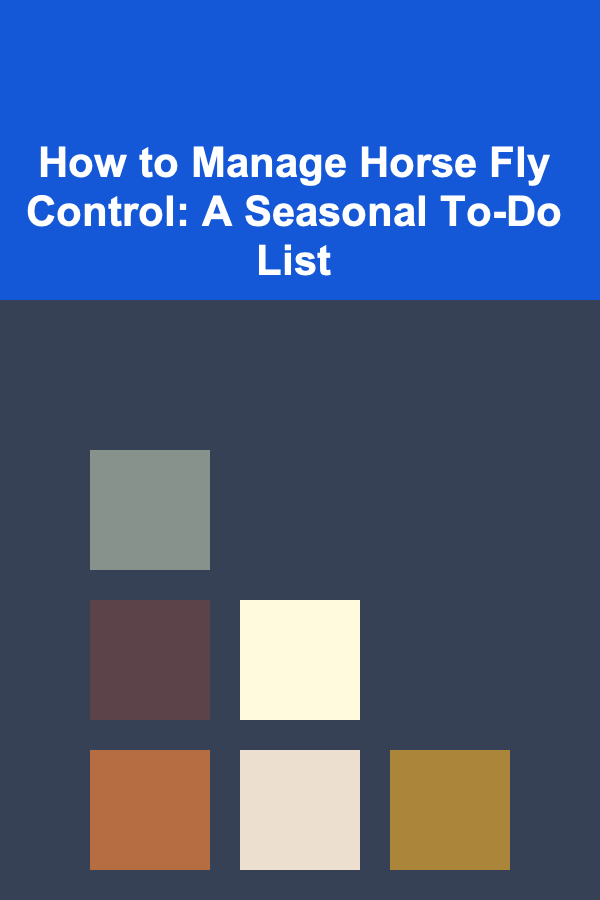
How to Manage Horse Fly Control: A Seasonal To-Do List
ebook include PDF & Audio bundle (Micro Guide)
$12.99$7.99
Limited Time Offer! Order within the next:

Horse flies are among the most persistent and irritating pests for both horses and livestock, especially during the warmer months. These biting insects are not only annoying but can also cause discomfort, health issues, and in some cases, transmit diseases. As a result, effective horse fly control is essential for anyone involved in the care of horses, livestock, or even recreational riders.
Managing horse fly control requires year-round attention, but the intensity and focus of your efforts should vary depending on the season. Developing a seasonal to-do list helps you stay on top of these pests, preventing infestations before they become an issue. This article outlines how to effectively manage horse fly control throughout the year, from preparation in the cooler months to active management during peak fly seasons.
Understanding Horse Flies: Why Control Is Crucial
Horse flies, scientifically known as Tabanus species, are large, blood-feeding insects. Their bites are painful, and their feeding behavior often causes horses to panic, run, or exhibit signs of distress. Horse flies can also transmit several diseases, including equine infectious anemia (EIA), as well as causing secondary infections due to the irritation they create.
The female horse fly is the one that feeds on blood, using the nutrients to help her eggs develop. Unlike other biting flies, horse flies tend to have a stronger bite and often feed for longer periods, making them more problematic.
Horse Fly Life Cycle
Before we dive into seasonal control strategies, it's important to understand the life cycle of horse flies:
- Eggs: Female horse flies lay their eggs on plants, particularly along riverbanks, streams, and near marshes. Eggs hatch in the summer months.
- Larvae: After hatching, larvae develop in moist environments like mud or decaying vegetation. They can take several months to develop fully.
- Pupae: The larvae then pupate before emerging as adult flies in late spring or early summer.
- Adults: Adult horse flies are most active in the warmer months, typically from late spring to early fall.
Understanding this cycle helps identify when interventions should take place. The management strategies outlined below take this natural progression into account, helping you control horse fly populations at the right times of the year.
Spring: Preparing for the Horse Fly Season
Spring is the season of transition when horse flies begin to emerge from their pupal stage and start searching for a blood meal. While they aren't yet in full force, it's important to start preparing for their arrival. Proper early-season management can prevent infestations later in the year.
Key Spring Actions:
- Remove Breeding Grounds: Horse flies lay eggs on vegetation, so remove any dense brush, tall grasses, and plants from the areas where your horses frequent. Focus on areas near water sources, such as ponds, streams, or marshy areas, where horse flies typically lay their eggs.
- Install Fly Traps: Set up fly traps designed specifically for horse flies. These traps typically use attractants to lure the flies and capture them. There are several options available, such as baited traps or traps with reflective surfaces that attract flies. Place these traps near the areas where horses are most often kept, such as pastures or stalls.
- Assess and Clean Stables: Thoroughly clean stables and barns, especially those areas that may have been in use over the winter. Horse flies often rest in the dark, moist corners of these environments, so keep them well-ventilated and dry.
- Apply Preventative Fly Repellents: Start applying fly repellents to your horses early in the season. There are a variety of chemical and natural repellents available in sprays, wipes, and creams. Be sure to choose a repellent designed to target horse flies and apply it according to the manufacturer's instructions.
Summer: Active Horse Fly Management
Summer is the peak of horse fly season, with flies at their most active. During this time, horse flies are at their most persistent, and their presence can become overwhelming. It's crucial to intensify your control efforts and regularly monitor the situation to prevent the flies from affecting your horses' health and comfort.
Key Summer Actions:
- Monitor Fly Populations: Keep track of how many horse flies are present in your horse's environment. If you notice an increase in the number of flies, it may be time to step up your control measures. Consider placing additional traps and ensuring they're placed in high-traffic areas where your horses are most often.
- Use Electronic Fly Zappers: For barns and stables, consider using electronic fly zappers. These devices attract and kill adult flies with UV light. They can be very effective in reducing fly populations indoors, especially in dark areas where flies tend to congregate.
- Fly Sheets and Masks: Equine fly sheets and masks are excellent tools for protecting your horses from horse flies. These protective coverings are made of lightweight mesh and help keep the flies from landing on the horse's body or face. Make sure the horse sheets and masks are sized properly for comfort and coverage.
- Fly Control Feed Additives: Some feed additives, such as garlic-based products or specific essential oils, can make a horse's blood less attractive to flies. Adding these to your horse's diet may help repel horse flies and minimize their attraction to your horses.
- Continue to Apply Repellents: Reapply repellents frequently during the summer, especially if it rains or after heavy sweating from exercise. Pay extra attention to your horse's vulnerable areas, such as the legs, belly, and face, where horse flies are most likely to bite.
- Focus on Stabling and Pasture Management: During the summer, make sure your stables are maintained to prevent fly breeding. Horse flies lay eggs in decaying organic matter, so keep manure piles well-managed and removed regularly from pastures. Use proper drainage in stalls and paddocks to avoid standing water, which attracts breeding.
Fall: Prevention and Control for Next Season
While horse flies start to dwindle as the weather cools in the fall, this season is critical for wrapping up any last-minute control measures and preparing for the next year's fly season. The larvae are still developing in the environment, and the transition between seasons is an excellent time to reinforce your control strategies.
Key Fall Actions:
- Clean Pastures and Stalls Thoroughly: Continue removing manure from pastures and stalls. Even though the fly population is winding down, maintaining clean areas reduces breeding grounds for the next season. By doing so, you limit the chance for larvae to develop into adults.
- Check and Repair Fly Traps: If you have fly traps set up around your property, make sure they're still in good condition. Replace damaged traps or add new ones to monitor any remaining fly activity. Fly traps can also be effective in preventing early-season problems when the weather starts to warm up again.
- Remove Dead Fly Debris: After a summer of fly management, there may be dead flies in your barns, stables, and other areas where flies have been caught. Remove this debris to avoid attracting new flies and to maintain a cleaner environment.
- Store Fly Protection Gear Properly: Clean and store your fly sheets, masks, and other gear for the winter. Check for any damage and repair any issues before the next season.
- Plan for Early Spring Preparations: Begin thinking ahead to the following spring. Have your fly traps and repellents ready, and review your seasonal strategy to ensure you're well-prepared when the first horse flies start to emerge.
Winter: Off-Season Management and Planning
Although horse flies are not active in the winter, this season is crucial for ensuring that you're ready for the next year. Proper off-season maintenance of equipment, cleaning areas, and planning for the upcoming season can help reduce the amount of effort needed when the weather warms up.
Key Winter Actions:
- Review Equipment and Tools: Take time to assess your fly traps, repellents, and other control equipment. Replace anything that's worn out or damaged, and make sure your tools are in good condition for the next season.
- Maintain Property Cleanliness: While horse flies aren't active, maintaining cleanliness on your property during the winter will make your spring preparations easier. Clear debris, keep stalls and paddocks in good condition, and ensure your horse's living areas are ready for the next year.
- Research New Control Options: Winter is the perfect time to review the latest horse fly control products. Look for new repellents, traps, or other tools that may be more effective in the coming year. Research new strategies and advancements in pest management for horses, so you can improve your overall control plan.
Conclusion
Managing horse fly control is an ongoing process that requires seasonal attention. By following the seasonal to-do list outlined above, you can help keep horse flies at bay and ensure the comfort and health of your horses throughout the year. Effective control involves not just reacting when flies become a problem but planning ahead, implementing preventative measures, and staying vigilant. By maintaining a consistent, year-round strategy, you'll be able to significantly reduce the negative impact of horse flies and create a more comfortable environment for your horses.
Reading More From Our Other Websites
- [Home Maintenance 101] How to Prevent Mold and Mildew in Your Bathroom
- [Home Family Activity 101] How to Set Up a Family Science Fair at Home
- [Home Budget Decorating 101] How to Create a Stylish Home Office on a Budget
- [Stamp Making Tip 101] From Rubber to Polymer: Beginner‑Friendly Materials and Tools for Crafting Stamps
- [Horseback Riding Tip 101] Best Equestrian Retreats: Discovering the World's Most Luxurious Horseback Riding Destinations
- [Organization Tip 101] How to Choose the Right Storage Solutions for Pet Toys
- [Organization Tip 101] How to Keep Your Drawer Tools Clean and Organized
- [Personal Investment 101] How to Set Up a Trust Fund for Future Generations Through Investment
- [Organization Tip 101] How to Create a Relaxing Boho Retreat with Minimal Effort
- [Organization Tip 101] How to Create a Floor Plan for Your New Home

How to Refresh Your Outdoor Space Without Spending a Lot
Read More
How to Set Up a Cozy Family Reading Corner for Quiet Time
Read More
How to Set Up an Emergency Fund as Part of Your Home Budget
Read More
How to Soundproof a Shared Wall with Your Neighbor
Read More
How to Turn Unused Spaces into Functional Storage Areas
Read More
How to Build AI for Human-Computer Interaction
Read MoreOther Products

How to Refresh Your Outdoor Space Without Spending a Lot
Read More
How to Set Up a Cozy Family Reading Corner for Quiet Time
Read More
How to Set Up an Emergency Fund as Part of Your Home Budget
Read More
How to Soundproof a Shared Wall with Your Neighbor
Read More
How to Turn Unused Spaces into Functional Storage Areas
Read More